March 4, 2020
Writers + Artists (and sometimes Actors) Forge a Creative Marriage of the Verbal and the Visual
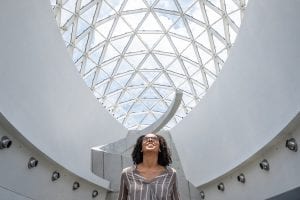
In the summer of 2012, USFSP professor Cynthia Leung and teachers from her class on writing at the College of Education came to the Dalí Museum for a lesson in ekphrasis. I was giving classes at the museum at the time, using paintings from the collection as prompts for memoir writing — a variation on the ekphrastic theme — so I was invited to participate.
It was the director of the Dalí Hank Hine who had introduced Leung (and me) to the concept of ekphrasis, the oldest type of writing about art developed by the ancient Greeks.
He suggested that her students, most of whom would become teachers in local schools, should first explore the Dalí collection and write about a painting without knowing anything about that work. Then after someone from the Dalí provided some background about the painting, the teachers would write a second piece, taking into consideration this new information. They would then compare the two writings — and develop lesson plans for their K-12 students to come to the Dali for their own ekphrastic sessions.
Fourteen teachers attended the June session. At the end of the first hour when the teachers had completed their writings about one of the paintings, Peter Tush, the museum’s Director of Education, the teachers and I gathered around the first chosen painting. In front of the painting, the teachers read what they had written. Tush then provided biographical and historical information related to the paintings and I weighed in on the teachers’ writings.
“I really liked how we got an inside view of the paintings we had chosen,” one of the teachers wrote in a class evaluation. “It was interesting to compare our perceptions on the painting and learn the meaning of each one.”
“I liked being able to write about the art and share with my peers,” wrote another.
“Having the support of the Dalí Museum… made me feel like we were creating something innovative for the community. It gave purpose to making a lesson plan that was beyond just completing an assignment for class.”
Leung, working with Peter Tush, continued to offer the ekphrastic lessons to her graduate students for the next six years. Now a professor emerita, she lives in Colorado where she cares for her twin grandchildren while her daughter is at work. Recently she sent along the advice she gave her students before their trips to the Dalí as well as a few ekphrastic poems she herself wrote during those ekphrastic sessions:
on Geopoliticus Child Watching the Birth of the New Man (1943)
The creation of the earth was a painful process
Bring together the oceans and the continents.
Man’s entry onto the world’s stage
Led to a series of developments
Some peaceful, serene, others violent.
Man is now emerging from this earth,
Breaking through the shell as a newborn chick.
The destitute and hesitant watch as the new man emerges
Hoping the future of the earth will bring
New inspiration to the human race.
on Fountain of Milk Spreading Itself Uselessly on Three Shoes (1945)
Madonna on a pedestal
Her child the dry earth
Milk streaming from her breasts
Aimed at the dry earth
A faceless man learning on a pole
Topped with a cross
Stomach distended
Abandoned shoes not to be claimed
Light from the heavens
Streaming down on the green village and hills
Like milk from the Madonna’s breasts
A rock smooth and sharp on one side
Curved and unsymmetrical on the other
Madonna brings hope to the earth
Her fertility and nourishment
To bring back the greenness of the villages
on Morphological Echo 1934-36
Morphology, the smallest element of meaning, yet
Morphing, to change to another element.
The girl, gliding across the barren sands
Her shadow preceding her
Jumping rope with her arms extended
Her full skirt echoed in the fullness of the school bell.
Openings, cutouts of rock formations
Echo from the bell tower to the window to the rocks.
A flag pole with a white flag of truce
Suggesting, “I give up. See what you can see.”
Away from the town in the distance
Morphological elements are not tied
To the common mind or traditional interpretations
Interpret as you wish.
The church and school ever present in the distance
Even when separated by space.
A darkened room above the barrenness
The potential for meaning.
Morphology and echoes of meaning.
— Cynthia Leung
. . .

Isn’t it ekphrastic?
From the first Fantastic Ekphrastic event in 2015 at Soft Water Studios in the Warehouse district sponsored by Keep St. Pete Lit to last month’s trek by Wordier Than Thou to Tampa International Airport to write about the public art there, ekphrastic events are all the rage in Tampa Bay.
Ekphrasis/Ek’phrasis (ekphrastic is the adjective), a tradition that dates back to Homer describing in great and dramatic detail the shield of Achilles in The Iliad, is the literary description of or commentary on a work of art. The marriage of the verbal and the visual.
The area’s next ekphrastic event will held on March 8 at The James Museum of Western & Wildlife Art in downtown St. Petersburg. Led by Sean Sexton, a poet and painter whose family has been in the cattle ranching business on Florida’s West Coast for the past 78 years, Wildlife Art as Muse: An Ekphrastic Poetry Workshop will use the museum’s paintings to inspire poetry.
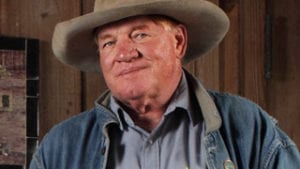
“It seemed like a natural for a museum in an urban setting,” says Sexton. “We can’t go outside and write about nature but we will be only steps away from works of art.”
I am talking to Sexton by telephone. He is at his family home, the Treasure Hammock Ranch, a 600-acre spread in Indian River County near Vero Beach where three generations of Sextons have run a cattle business and where he lives and works alongside his wife and fellow artist Sharon Sexton.
What should workshop participants expect from the ekphrastic workshop at The James?
Before workshop participants head into the galleries to create their own ekphrastic poems, Sexton says, he will give them examples of classic ekphrastic works such as John Keat’s “Ode to a Grecian Urn” and John Ashbery’s “Self-Portrait in a Convex Mirror,” based on a Renaissance painting, and also some of his own. Sexton has written two ekphrastic poems based on etchings by his friend Michael Kemp, a printmaker whose studio is in Micanopy (Sexton often goes there to do his own printmaking).
Collaboration between writer and artist can run both ways, he points out. A visual work of art also can be inspired by a verbal one. Charles Demuth’s 1928 painting Saw the Figure 5 in Gold, for example, was inspired by “The Great Figure,” a poem written by his friend William Carlos Williams. The poet wrote the poem after he saw a fire engine speeding down a rainy New York street.
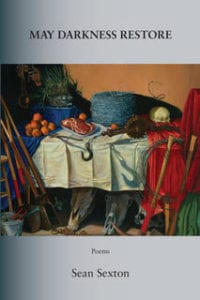
Sexton is a natural to give a workshop that combines words and images. Now 65, he has been a poet and painter nearly all of his life. Like a lot of kids, he started to draw in grade school, but unlike most kids who grew out of it, he never did. “I grew it up inside me instead,” he tells me. Writing on a regular basis didn’t come until college. He took a class where the assignment was to keep a journal. “I never stopped,” says Sexton.
In 2016 Sexton was named the first poet laureate of Indian River County. In addition to poetry (“I write lots of poetry”) he also writes creative nonfiction pieces on topics ranging from his dealings with cattle at the ranch to a memorable trip he took in 1995 to Washington where he braved a government shutdown and a blizzard to see a Vermeer exhibit at the Smithsonian.
On March 7 at 2 p.m., the day before the ekphrastic workshop, Sexton will appear at The James for an author talk called Florida Made: Cowboy Poetry, Art & Cattle Ranching. He will show some of his artwork, talk about ranching and read poems from his second book of poetry, May Darkness Restore, published last year by the Winston-Salem-based Press 53. An example of his artwork graces its cover: a massive 72-inch-by-84-inch oil painting called Allegory of Work, a still-life of farm tools, a slab of steak, a roll of barbed wire and a skull.
Every year since 2009 Sexton has read his poetry at the National Cowboy Poetry Gathering in Elko, Nevada, but he admits he doesn’t completely embrace the cowboy poet moniker. How does he prefer to be labeled? “A post-modern, post-existentialist pastoralist,” he chuckles.
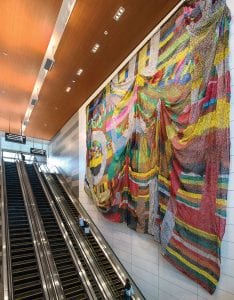
Next time you’re taking a flight out of or into Tampa International Airport, you might want to bring along a notebook and try an ekphrastic poem or essay yourself. The airport is chock-a-block with art, from the 22 tapestries woven by Swaziland artists in the main Terminal to Palimpsest, a tapestry made primarily of beads by Chicago-based sculptor and performance artist Nick Cave (who was part of Lights on Tampa in 2015) in the Rental Car Center.
Last month members of the Wordier Than Thou Meet Up for Writers and Book Lovers did just that, gathering at TIA for an Ekphrastic Writing Workshop. Wordier Than Thou, founded by Tiffany Razzano, has been organizing events throughout West and Central Florida since in 2012.
Every Saturday, TIA offers an all-access gate pass to non-traveling guests who want to check out the food, drink and art offerings. The Wordier Than Thou group chose Airside F for its ekphrastic session where they could write up descriptions of three installations: Goodbye My Love Tampa Seven Days a Week, a hanging sculpture composed of seven wings by Cuban-born artist Esterio Segura; Verdant Tampa Bay, a landscape painting by Tampa-based Elisabeth Condon (she used to teach at USF before quitting to do art full-time), and Tendril, a hanging sculpture made of ribbon-shaped metal strips and LED screens by Madrid-based Daniel Canogar.
My favorite art at the airport is n + 1, a sculpture by American artist Ralph Helmick of a leatherback sea turtle suspended in the SkyConnect area in the Main Terminal. Floating behind the 10-foot wide turtle are a thousand tiny sculptures of turtle hatchlings hung to echo exactly the shape of the larger turtle.

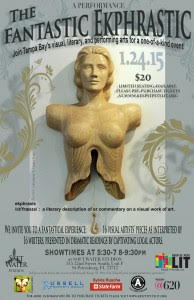
Most people from the Tampa Bay area first heard the word ekphrastic when Keep St. Pete Lit held its first Fantastic Ekphrastic fundraiser on January 24, 2015 at Soft Water Studios in St. Petersburg’s Warehouse District. The group, led by poet Maureen McDole, has offered a half a dozen ekphrastic events since.
I met up with McDole inside the cavernous space of the Behar + Peteranecz Architecture firm at 2430 Terminal Drive South, near the site of that very first Fantastic Ekphrastic. The firm, which offers Keep St. Pete Lit desk space and use of its facilities, is readying for the launch this fall of a project called The Factory St. Pete, a massive art space (eight warehouses spread across 6.5 acres) where McDole’s nonprofit will finally have permanent headquarters.
. . .

As I entered the cavernous room, appropriately, I was greeted by an ekphrasis: a pink bicycle (well, half of one anyway) by sculptor Katee Tully placed under a poem on the wall by Helen Pruitt Wallace that begins “A girl on a bike” from her poetry collection The Pink Streets (listen to Wallace read that poem here. The pairing was part of Keep St. Pete Lit’s 4th annual Fantastic Ekphrastic.
How did the first Fantastic Ekphrastic come about? “Back then everyone was staying in their own lane,” McDole explains, referring to the early days of starting up Keep St. Pete Lit. “I was looking for a way to think outside the box.”
She wanted to find a way to marry writing and art. “That’s called ekphrasis,” Heather Jones, a playwright and creative writing teacher who was on the Keep St. Pete Lit board, told her. It was the first time McDole had heard the word. She decided Keep St. Lit needed to sponsor an ekphrastic event. Jones came up with the title Fantastic Ekphrastic.
The clever name struck a chord. The event sold out and put Keep St. Pete Lit on the local arts map.
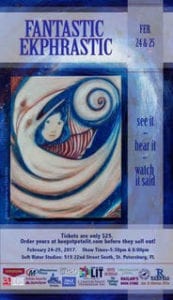 The show paired 16 local writers and 16 local artists with the added cache of adding actors to the mix. The alternative weekly Creative Loafing called it “a unique melding of the visual, performance and literary arts.”
The show paired 16 local writers and 16 local artists with the added cache of adding actors to the mix. The alternative weekly Creative Loafing called it “a unique melding of the visual, performance and literary arts.”
Creative Loafing had been one of the event’s sponsors and Its editor, David Warner, one of its participants. Warner now credits Fantastic Ekphrastic for bringing him back to writing, says McDole. “No one knew that he had a degree in drama.” (Warner got a master’s degree in theater from Villanova.)
The show was so popular the group did it again In 2016, using the same formula, but expanding it to two days on February 19 and 20. The poster, which featured one of the artworks that was to be included (Identifiability by Saori Murphy) promised “Sixteen pieces of art, interpreted by writers, acted live.”
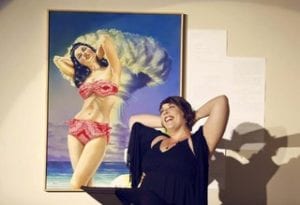
That year Creative Loafing’s Best of the Bay touted The People’s Choice Winner for Best Collaboration at the 2nd Annual Fantastic Ekphrastic. It went to Lance Rodgers, Sheila Cowley and Becca McCoy. Cowley wrote a one-act play inspired by Rodgers’ painting Bikini Atoll Bombshell which was performed by McCoy. [Disclaimer: Sheila Cowley is Managing Editor of the Arts Coast Journal.] Second Place went to Sall & Son by Cora Marshall, described by John Pendygraft and performed by Sandra Gadsden. Receive by artist Suzy Schultz, writer Frank Wells and actor Bob Devin Jones took third place. As he did for the first Fantastic Ekphrastic Devin Jones directed the evening’s performances.
By 2017 people knew to get tickets early to the sold-out sessions held on February 24 and 25, again at Soft Water Studios and again combining the talents of writers, artists and actors. “See it… hear it… watch it said,” read the event poster.
All proceeds went to help fund Keep St. Pete Lit and its activities, including low-cost writing classes at the Morean Art Center, LitSpace Writers Residency program at Craftsman House Gallery, the annual SunLit Literary Festival, a used bookstore at Morean Art Center and kids summer writing camps.
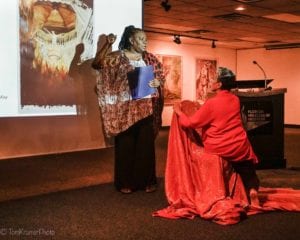
Also in 2017 Keep St. Pete Lit held what Creative Loafing called a “Holocaust ekphrastic,” asking writers and performers to react to The Holocaust and the Book of Fire, an exhibit by Murray Zimiles, the stepson of a Holocaust survivor, on display at the Florida Holocaust Museum in downtown St. Petersburg. “His work asks: Where was God during the Holocaust? Where was civilization?” wrote Cathy Salustri in Creative Loafing.
Salustri had been a participant in the first Fantastic Ekphrastic. The Holocaust Museum originally scheduled the show for September, but had to postponed it when Hurricane Irma hit. On October 14, Peter Meinke, Bob Devin Jones, Sandra Gadsden, Cindy Stovall, Lisa Kirchner, Lisa Spencer and Bob Schwartz all presented original works at the museum while actor Fanni Green and dancer Paula Kramer collaborated on a piece by Sheila Cowley.
Two more Ekphrastic projects were offered by Keep St. Pete Lit in 2018 and 2019. In 2018 an ekphrastic writing workshop was held at Florida CraftArt where participants wrote about the artwork the exhibition Dia de Los Muertos: A Celebration of Life. In 2019 in an event dubbed a Literary Carousel, photography from the Museum of Fine Art’s collection was the inspiration for ekphrastic writing — both poetry and prose — by Roy Peter Clark, Silvia Curbelo, Lee Irby, Jon Kile, Lisa Kirchner, McDole, Cindy Stovall and Shelly Wilson.

Most of the hookups between words and art during ekphrastic events have been fleeting, of course. Like brief love affairs after which each partner goes his or her separate ways, ekphrasis are often ephemeral events. Not all of them, however. “That young girl, one day, was gone,” Helen Pruitt Wallace concludes in her poem about her youthful bike ride in The Pink Streets, but her poem is now forever alive, linked to Katee Tully’s half of a pink bike. And right around the corner from that pairing at the firm on Terminal Drive is a wall that pairs Peter Meinke‘s poem “Walking by the Dalí Museum” with the painting by muralist Chad Mize that the poem inspired.
That ekphrasis was part of last year’s 5th annual SunLit Festival, a fundraiser for Keep St. Pete Lit’s children’s literary programs that “foster self-esteem, literacy and creativity in local children,” wrote Meinke in his Creative Loafing column. “My poems aren’t as sunny as Chad’s typical artwork but we’re together in our firm belief that St. Pete’s heading in the right direction,” he added, “and with sense and sensibility (watch those condo$!) will continue to do so for a long time to come. We’ve survived Governor Scott and we’re going to survive President Trump as well. As the Youth on his impossible journey cries in Wordsworth’s famous poem, ‘Excelsior!’”
Or as Meinke says in his own poem:
I feel
free I feel free and now
the butterflies start growing heels
the heels are growing noses/this is growing
complicated that’s how I know it’s
real


